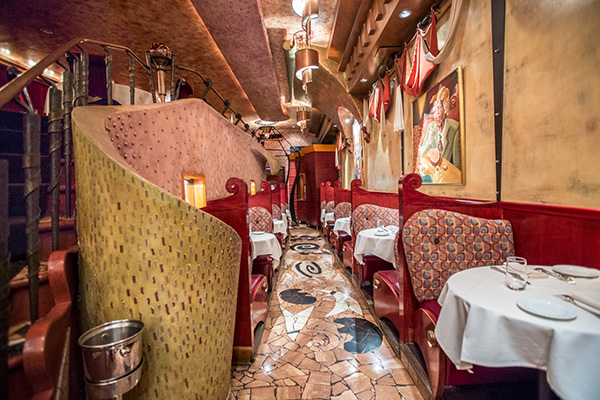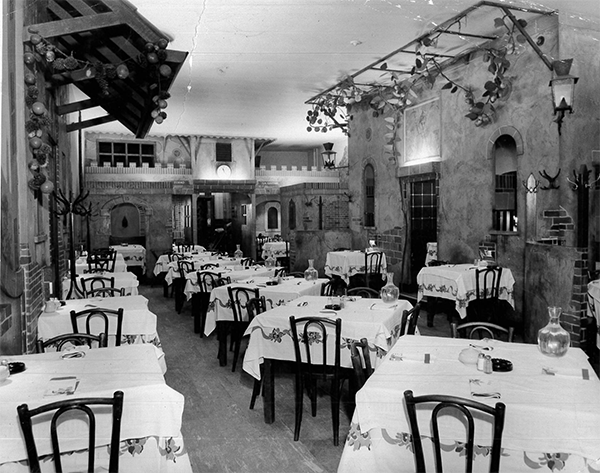In a city of about 7,300 restaurants and 2.7 million humans who are mostly creatures of habit, it's easy to overlook the dining institutions among us. This was the case for me, a 26-year customer of the three-restaurants-in-one Italian Village, who rarely ventured outside of the subterranean chophouse La Cantina, nor beyond my usual cup of minestrone and spaghetti with meat sauce.
The Italian stalwart turns 90 this year—one of just a handful of spots across the city to flirt with a century in business. Starting with the Village in 1927, followed by La Cantina in 1955, then contemporary Vivere (originally the Florentine) in 1961, this barrel-roofed temple to Italian food and wine has withstood decades of splashy restaurant openings (and closings) and a changing Loop that’s sprouted shiny new complexes on all sides of its 71 West Monroe location.
It’s passed through three generations of Capitaninis—from Italian immigrant Alfredo to his granddaughter and current owner Gina. It’s also built one of the city’s most impressive wine cellars, won dining accolades from near and far, and cemented a place in Chicago food lore.
I’d eaten at La Cantina at least once a year since my family moved to Chicago in 1991, usually following a matinee showing of the Nutcracker ballet. But being a loyal customer didn't make me an adventurous one, and I had rarely been to the other two restaurants onsite, nor had I tested the seafood, steaks, and chops for which La Cantina is known.
That all changed last month, when five friends and I embarked on a progressive dinner through all three concepts, which staff affectionately call “running the circuit”—an hour each at the Village, Vivere, and La Cantina—on a tour that became as much about sharing a childhood gem with friends as gaining an appreciation for the full trio and its unprecedented longevity.

The six of us met early on a Friday night at the Village, which was so packed that people spilled halfway down the stairs. We squeezed into a red leather booth opposite the carousel-like bar, adorned with mini columns and Renaissance-style statues. The interior—bedecked in frescoed walls depicting a little Italian town complete with winking window lights—somehow recalls a miniature Tuscany and turn-of-the-century Chicago in equal measure. Founder Alfredo commissioned Livio Macrini, whom he’d met at the World’s Fair, to design it.
Alfredo claimed to have invented chicken vesuvio here, the famous Chicago dish (with even more famously disputed origins) of roasted chicken simmered with garlic, oregano, and wine. Legend also has it that in the Village’s early days, Al Capone used to frequent one of the back booths, in case he had to make a quick getaway out the back door. The Capitaninis embraced that myth, too, redesigning the booth to resemble a jail cell and renaming it La Prigione (“jail”).
We ordered conservatively—a few platters of toothsome, grilled calamari swimming in garlicky oil and stacks of juicy tomato, creamy housemade burrata, and basil drizzled with sweet balsamic.
“Thirty-seven minutes to go,” warned my timekeeping friend, as we eyed my sister flicking indecisively through the enormous, leather-bound wine bible. We barely drained our shared bottle of bright vermentino before it was time to grab the bill and head downstairs to stop No. 2.
Vivere, which Gina, Al, and the younger Frank Capitanini reconcepted in the ‘90s, is billed as the most modern of the three. Las Vegas-esque whimsy permeates the baroque gold- and velvet-trimmed space, with a theatrical swirl motif across oversized light fixtures, brass columns, and asymmetrical, high-backed booths.

On the way down, we strategized that we’d stick to the handmade pastas Vivere is best known for—like saffron-infused tagliarini with Calabrian chiles, shrimp, and garlic; ribbony tagliatelle with meaty ragu; and—my favorite—the autumnal, pheasant-filled agnolottini bathed in butter and sage. Amidst our plotting, wine director Jared Gelband dropped by with the formidable wine book.
“We’ll take the chianti in the grass skirt,” our timekeeper announced, referring to the affordable Tuscan Bell’agio chianti.
“Two bottles,” I added. “This time we have the whole hour.”
“Oh, are you guys running the circuit?” Gelband asked, making us erupt in delighted laughter. He offered to take us on a tour of the wine cellar before our final stop. “I do that sometimes for circuit runners,” he added breezily.
Counterintuitively perched on the third level past offices and employee lockers, this bi-level cellar originally held the restaurants’ liquor but was outfitted into a climate-controlled wine cellar after second-generation owner Ray started building up the list in 1981. The collection now comprises 25,000 bottles made up of 1,200 different labels and vintages, focusing on Italian classics that run the length of the boot and its surrounding islands—from Piedmontese barbera to Tuscan sangiovese and Sicilian nero d’avola.
Gelband told us that sustaining such a large list and buying bulk quantities of wines has helped the group hang onto vintage wines for a long time. They can offer high-quality wines for affordable prices “because we got them at such a great price upon release,” he explained, adding that the group made a conscious choice to keep the prices relatively low.

Gelband’s favorite? The “powerhouse” 2004 Casanova Di Neri “Cerratalto” Brunello di Montalcino for $350. For the cheapskates like us, he recommended the Alto Piemonte wines—“specifically, the 2011 Travaglini, of nebbiolo grown in Gattinara, for $60.”
We were behind schedule when we finally descended the stairs into grotto-like La Cantina. Manager and 35-year vet Hans Kurt (who had also walked a twirling, seven-year-old me to her table 26 years ago) led us through the narrow, warmly lit front dining room outfitted in wine-related sundries to the slightly wider back dining area.
Originally opened 62 years ago by second-generation Capitaninis Frank, Ray, and Ave, La Cantina was renovated in 2015 when the concept also shifted its focus from seafood to steaks and chops. For my sister and me, that meant saying goodbye to built-in fishtanks that used to line our favorite stretch of cozy booths in back.
We decided to end on chicken Parmesan and filet mignon with a side of garlicky spinach. Kurt suggested a palate-cleansing salad course first (which also miraculously jumpstarted our fading appetites). He then brought over a surprisingly delicate nebbiolo to complement the buttery, tender beef and hearty, gooey chicken Parm. As the realization sunk in that our enchanting journey through Italian-Americana was ending, we started planning how we might alter our next circuit run. (“We have to get the chicken vesuvio at the Village next time!”)
“How are we feeling dessert-wise?” Gelband asked. Our collective groans ceased the moment he suggested we could have our coffee and crème brûlée in Vivere’s bar. One more stop! Not to mention that the dark, curvy nook hidden beneath Vivere’s mezzanine dining room was quickly becoming my new favorite spot in the whole place. Of course, I’d never tell Kurt this.
He stopped by once more, pausing to rest a hand on the back of my sister’s chair. “We’ll see you girls again soon, yes?” he smiled. I could already taste the meat sauce.



